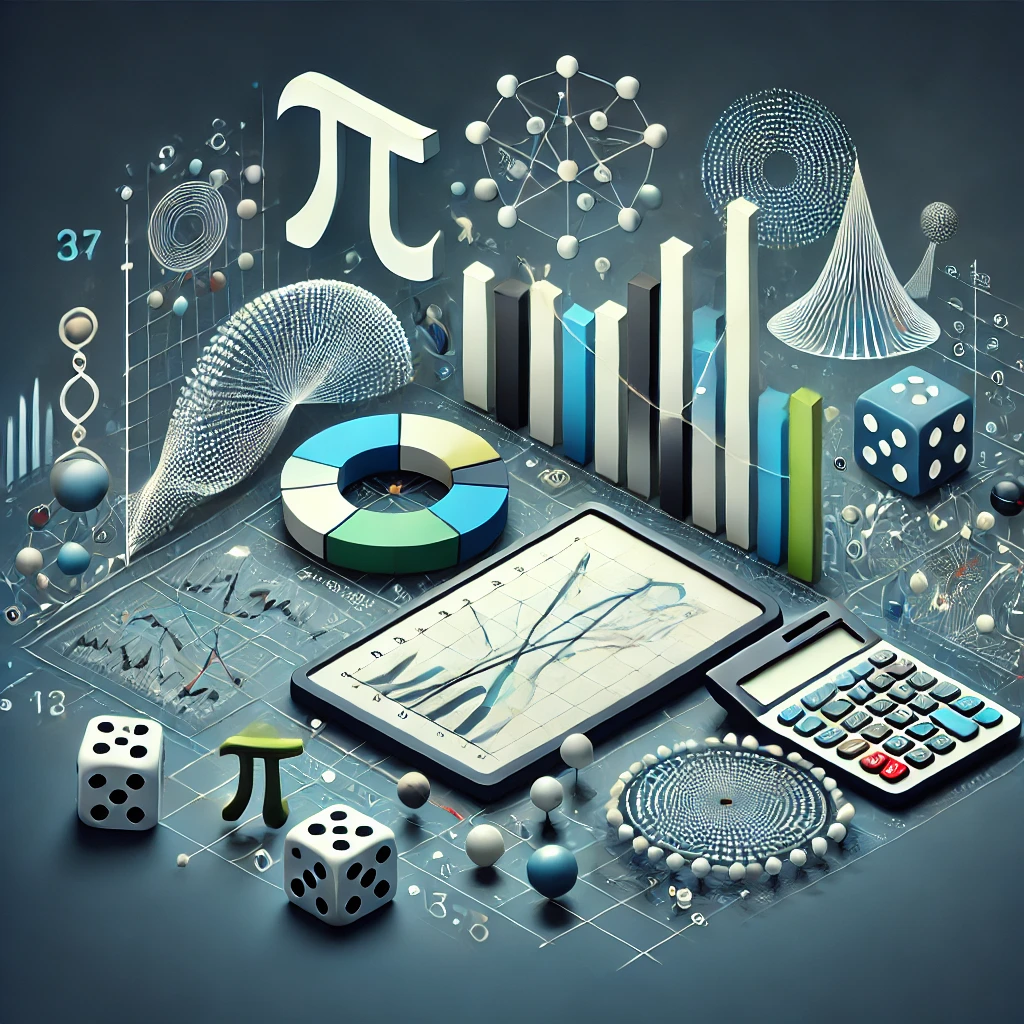Statistics and Probability: Foundations of Data and Uncertainty

Statistics and probability are essential branches of mathematics that play a pivotal role in various fields, including science, engineering, business, and social sciences. While statistics focuses on the collection, analysis, and interpretation of data, probability deals with predicting the likelihood of events. Together, they provide powerful tools for decision-making and understanding the randomness inherent in the world.
Understanding Statistics
Statistics can be broadly divided into descriptive and inferential statistics. It provides a framework for analyzing real-world data and drawing meaningful conclusions.
1. Descriptive Statistics
Descriptive statistics summarize and organize data in a meaningful way.
- Key Concepts:
- Measures of Central Tendency:
- Mean (Average): The sum of all data points divided by the number of points.
- Median: The middle value when data is arranged in order.
- Mode: The most frequently occurring value.
- Measures of Dispersion:
- Range: The difference between the maximum and minimum values.
- Variance: The average of the squared differences from the mean.
- Standard Deviation: The square root of the variance, representing data spread.
- Measures of Central Tendency:
- Visual Tools:
- Histograms, bar graphs, and pie charts help visualize data distribution.
- Box plots illustrate data spread and outliers.
2. Inferential Statistics
Inferential statistics use sample data to make predictions or generalizations about a larger population.
- Key Techniques:
- Hypothesis Testing:
- Determines whether an assumption (null hypothesis) about a population parameter holds true.
- Confidence Intervals:
- Provide a range of values likely to include a population parameter.
- Regression Analysis:
- Examines relationships between variables to make predictions.
- Hypothesis Testing:
Understanding Probability
Probability is the mathematical study of uncertainty. It quantifies the likelihood of events occurring in a given context.
1. Basic Concepts
- Experiment: A process with a well-defined set of possible outcomes.
- Sample Space (SS): The set of all possible outcomes.
- Event: A subset of the sample space.
- Probability Formula:
P(E)=Number of favorable outcomesTotal number of outcomesP(E) = \frac{\text{Number of favorable outcomes}}{\text{Total number of outcomes}}
2. Rules of Probability
- Addition Rule: For mutually exclusive events AA and BB: P(A∪B)=P(A)+P(B)P(A \cup B) = P(A) + P(B)
- Multiplication Rule: For independent events AA and BB: P(A∩B)=P(A)⋅P(B)P(A \cap B) = P(A) \cdot P(B)
- Complement Rule: The probability of the complement of an event AA is: P(Ac)=1−P(A)P(A^c) = 1 – P(A)
3. Conditional Probability
The probability of event AA occurring given that BB has occurred is:
P(A∣B)=P(A∩B)P(B)P(A|B) = \frac{P(A \cap B)}{P(B)}
4. Bayes’ Theorem
A fundamental formula for updating probabilities based on new evidence:
P(A∣B)=P(B∣A)⋅P(A)P(B)P(A|B) = \frac{P(B|A) \cdot P(A)}{P(B)}
Applications of Statistics and Probability
- Business and Finance:
- Forecasting market trends.
- Risk analysis and portfolio management.
- Healthcare:
- Analyzing clinical trial results.
- Predicting disease outbreaks.
- Engineering:
- Quality control in manufacturing.
- Reliability testing of systems.
- Social Sciences:
- Survey analysis and public opinion studies.
- Artificial Intelligence and Machine Learning:
- Probability models like Bayesian networks.
- Statistical learning for pattern recognition.
Key Statistical Distributions
- Uniform Distribution:
- All outcomes in the sample space are equally likely.
- Example: Rolling a fair die.
- Binomial Distribution:
- Describes the number of successes in nn independent Bernoulli trials.
- Example: Flipping a coin nn times.
- Normal Distribution:
- A bell-shaped curve, characterized by its mean (μ\mu) and standard deviation (σ\sigma).
- Common in natural and social phenomena.
- Poisson Distribution:
- Models the number of events occurring in a fixed interval of time or space.
- Example: Number of customer arrivals in a store per hour.
- Exponential Distribution:
- Models the time between events in a Poisson process.
Statistical Analysis Process
- Define the Problem:
- Identify objectives and formulate hypotheses.
- Collect Data:
- Use surveys, experiments, or observational studies.
- Analyze Data:
- Apply appropriate statistical methods.
- Interpret Results:
- Translate statistical findings into actionable insights.
Real-World Example: Probability in Action
Scenario: A bag contains 3 red balls and 2 blue balls. What is the probability of drawing a red ball?
- Sample Space (SS): {Red, Red, Red, Blue, Blue}.
- Favorable outcomes (EE): {Red, Red, Red}.
- Probability: P(Red)=Number of red ballsTotal number of balls=35.P(\text{Red}) = \frac{\text{Number of red balls}}{\text{Total number of balls}} = \frac{3}{5}.
If a second ball is drawn without replacement, the sample space changes, demonstrating how probabilities adapt dynamically.
Challenges in Statistics and Probability
- Misinterpretation of Data:
- Correlation does not imply causation.
- Misleading visualizations can distort findings.
- Assumptions in Models:
- Many statistical models rely on assumptions that may not hold in real-world data.
- Data Quality:
- Incomplete or biased data affects reliability.
- Complexity in Calculations:
- Advanced probability models require computational tools.
Future Trends in Statistics and Probability
- Big Data:
- Handling large datasets with sophisticated statistical tools.
- Artificial Intelligence:
- Integration of probabilistic models in AI systems.
- Data Visualization:
- Advanced tools for presenting statistical findings intuitively.
- Interdisciplinary Applications:
- Expansion into fields like genomics, climate science, and urban planning.
Conclusion
Statistics and probability form the backbone of modern decision-making, providing a structured approach to analyzing data and navigating uncertainty. By understanding their principles and applications, we unlock tools essential for innovation and problem-solving in a data-driven world. Whether in science, business, or everyday life, these disciplines empower us to make informed choices with confidence.






